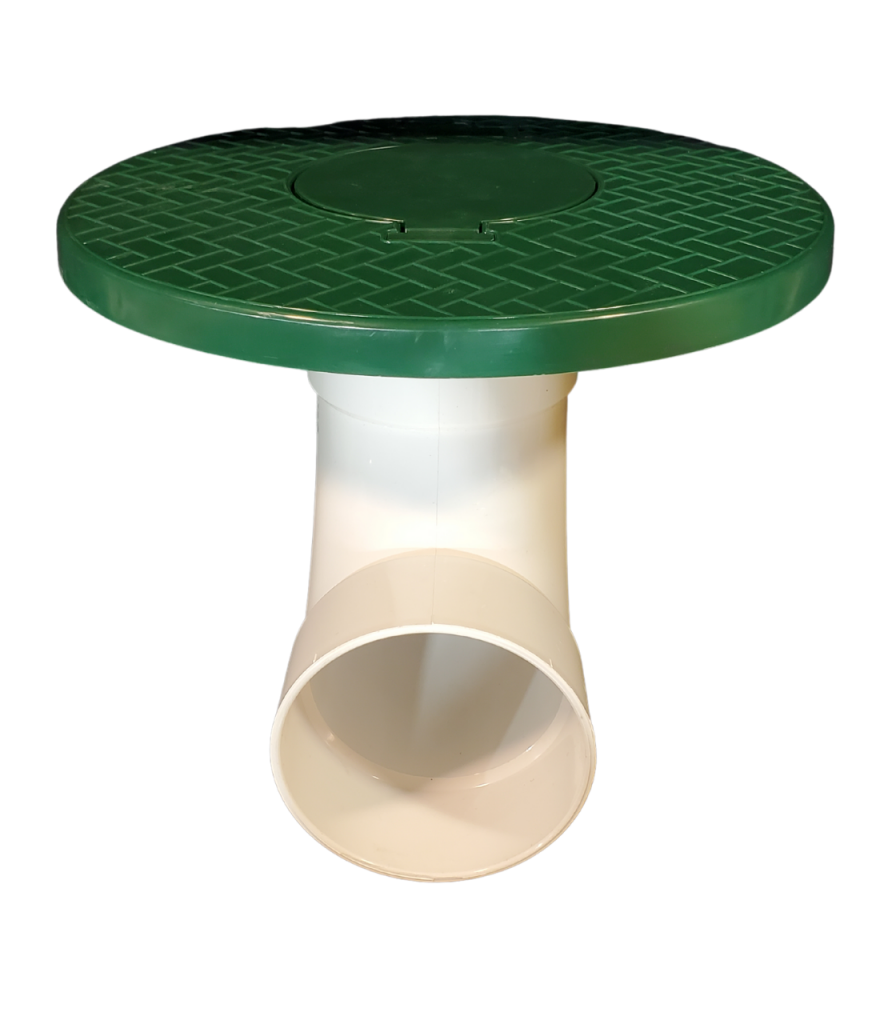The number one problem with using a pop up drain for downspouts is the grass will grow over it and then it can’t discharge the water. This has been an industry problem for decades and decades, and nobody has done a thing about it. I think the reason why is, in order to create a really significant turf restrictor plate, you’re going to use 10 times the material, and this is not what drainage companies want to hear. They want to make a small pop up emitter and use the smallest amount of material and have that pop up emitter cost as little as possible, so that they can maximize their bottom line.
FDM Develops Clog Free Pop Up Drain for Downspouts Out of Necessity
The pop up emitter is the number one go-to choice of landscapers for downspouts and other drainage because it doesn’t hold a lot of water. However, the FDM crew got away from pop up emitters for awhile because the vegetation grew over it and would clog the system. As drainage contractors, that’s a big liability. We could put the very best systems in the world and then when the grass grows over a pop-up, it can’t discharge. That’s when we tried switching to bigger speedy basins.
If you use either a 6 inch 9 inch or 12 inch basin for discharge, the grass won’t grow over your discharge and prevent your system from working. But the problem is these bigger basins hold so much water it becomes a breeding ground for mosquitoes and earthworms. It’s not fun at all. The water smells terrible and then if you’re in a cold climate with harsh winters that water is going to freeze solid.
 We had to come up with a drainage solution that didn’t hold water and wouldn’t have grass and vegetation growing over it. This is how we came up with FDM’s pop up emitter 2.0 and turf restrictor plate.
We had to come up with a drainage solution that didn’t hold water and wouldn’t have grass and vegetation growing over it. This is how we came up with FDM’s pop up emitter 2.0 and turf restrictor plate.
FDM’s Pop Up Emitter 2.0 Changes Downspout Drainage Forever
The pop up 2.0 and turf restrictor plate changed everything. We now offer a lawn pop up drain with 22 .5 degree, 45 degree or 90 degree elbows and they all come with a turf restrictor plate. We offer pop up emitters to fit any drainage pipe: thin wall PVC, SCH 40 PVC and corrugated in 3 inch or 4 inch configurations.
Now, if you want to reduce the amount of water that the 90 holds you can go to a 3 inch pop up because the 4 inch is going to hold more water.
Some might think, “Well, this is going to slow down my flow.” But it won’t. Fluid does not work that way. It’s called the mass flow rate. So you have a four-inch line. You have all this kinetic energy and the water is just moving. Then it hits a 3-inch piece. What happens is the fluid just speeds up into the 3 inch, but it will not slow down in the mass flow rate. If you go to a 3-inch in the north, you will leave even less water behind. You can just drill a little hole in the bottom and that amount will perk. This will never freeze up your downspouts in the winter.
Our Lawn Pop Up Drain Has the Largest Opening
There’s a lot of contractors that won’t use a spring-loaded pop up drain for downspouts. They believe that there’s too much resistance. and when the water pressure becomes less towards the end of a rain event, the spring will keep water in the line.
We don’t feel that way because when the water slows down, whatever water is going to exit will run out. Water weighs roughly eight pounds per gallon. When you consider PSI, pounds per square inch, a light duty spring is not going to be an issue. But in order to have a spring in the middle of a pop up emitter, you have a brace going across it. This means your opening is split in half with a bar of plastic that goes across it so that it can support a spring in the center. Some of them actually have more than just a bar across, like a forked bar, so you end up with three triangles, if you will. Now, leaves get caught on those which can clog the discharge area.
FDM’s V 2.0 is unique as it is a hinged pop-up. It has the widest opening of 4 inches and there are no bars going across it. There’s no way that a tree branch can get hung up in there. Now remember, if you have trees around your house, when the wind blows, you end up with sticks on the roof. When that stick or branch hits the roof, it shatters. The small pieces always end up in the gutter. I know this because I’m the guy that’s having to clean them out and remove these sticks. This big outlet will let the stick come out freely.



